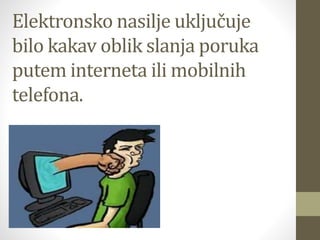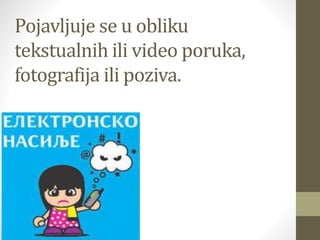1 of 5
Download to read offline





Ad
Recommended
┤▄▓╣┼Ī│┘Š▒│┘▓╣-▓į▓╣-Š▒▓į│┘▒░∙▓į▒│┘│▄
┤▄▓╣┼Ī│┘Š▒│┘▓╣-▓į▓╣-Š▒▓į│┘▒░∙▓į▒│┘│▄Mirjana Kokeri─ć
╠²
Dja─Źki parlament
O┼Ā "Branko Radi─Źevi─ć" SmederevoąĮą░čüąĖčÖąĄ ąĮą░ ąĖąĮč鹥čĆąĮąĄčéčā
ąĮą░čüąĖčÖąĄ ąĮą░ ąĖąĮč鹥čĆąĮąĄčéčāSmeh i suza
╠²
Nasilje na Internetu - za sajt https://sites.google.com/site/sigurninanetuLucy cyberbullying[1]
Lucy cyberbullying[1]laura swearingen
╠²
Cyber bullying involves saying mean things to others online or through electronics, which can make people feel sad if they are targeted. If someone witnesses or experiences cyber bullying, they should tell an adult about it. Instead of bullying, people should treat each other kindly online.Cyber bulling
Cyber bullingMatthew1298
╠²
The document provides brief instructions to never give in, not believe what others say, and instead tell, block, and report any issues. It also advises to stop and avoid being a bully.391 nasilje na internetu strip
391 nasilje na internetu stripPogled kroz prozor
╠²
Dokument isti─Źe va┼Šnost sigurnosti na internetu povodom Dana sigurnijeg interneta. Opisuje iskustvo zlostavljanja putem la┼Šnog profila na dru┼Ītvenoj mre┼Ši te nagla┼Īava opasnosti koje anonimni korisnici predstavljaju. Preporu─Źuje se prijava uvredljivih poruka administratoru i obavje┼Ītavanje roditelja o maltretiranju.Cyberbullying
CyberbullyingShelby Mitchell
╠²
Cyberbullying involves using electronic devices and communication tools to bully others online. A survey of students found that over 2 in 7 had been bullied online, and most felt it was easier to bully someone online than in person. The document recommends ways to prevent cyberbullying such as speaking to youth about its harms, creating school policies, and building community awareness.Bulingeduardo452
╠²
El documento describe el bullying o acoso escolar, las caracter├Łsticas del acosador y del acosado. Resumiendo: El bullying implica maltrato f├Łsico, verbal o psicol├│gico repetido entre estudiantes. El acosador carece de habilidades sociales y empat├Ła, y manipula la realidad. El acosado tiene baja autoestima y no puede defenderse, a menudo diferenci├Īndose de los dem├Īs.Cyber bulling
Cyber bulling Sadaf Walliyani
╠²
This document summarizes the results of a survey about social media usage and etiquette. It asks questions about which social networks people use most, whether people follow etiquette rules, how kindly or critically people behave online, and reactions to negative posts. The majority of respondents agree that rules are needed for social media. Cyberbullying is defined as deliberate hostile behavior online intended to harm others. The document concludes with tips on social media do's and don'ts.Cyber bulling
Cyber bullingcybersquad
╠²
Emma is cyber bullied by Courtney, who calls her ugly and fails. Emma blocks Courtney and never speaks to her again. The document provides tips for dealing with cyber bullying, such as telling a trusted adult and taking screenshots as evidence. It encourages spreading awareness of cyber bullying and their webpage.Cyber bulling
Cyber bullingjordan-and-haden
╠²
Cyber bullying involves tormenting, threatening, embarrassing, harassing or humiliating a child, preteen or teenager online or through digital technologies. There are two main types of cyber bullying: direct attacks through messages sent directly to the victim and proxy attacks where others help cyber bully the victim either knowingly or unknowingly. People cyber bully for reasons such as feeling bad about themselves, entertainment, or revenge. The document provides tips for preventing cyber bullying through education, telling someone if being bullied, teaching consequences and how to stop being cyber bullied by not responding, keeping evidence, blocking the bully and telling an adult for help. It also explains how to report cyber bullying to online service providers.cyber bulling
cyber bullingSadaf Walliyani
╠²
This document summarizes a group project on social networking conducted by five students - Iqra Asif, Inaara, Laveeza, Hussain, and Iqra Syed. It includes surveys completed by the group members on their social media usage and any problems experienced. It also discusses the benefits of social networking, etiquette to follow, and cyberbullying issues. The group faced challenges in data compilation and conducting surveys, but were able to solve these problems with help from their teacher and continued effort.Cyber Bulling Presentation
Cyber Bulling Presentationvasta1sk
╠²
Cyber-bullying children discusses the issue of cyberbullying of students. It defines cyberbullying as one child targeting another using electronic means such as text messages, websites, and social media. The document notes that cyberbullying happens frequently, with 4 out of 5 middle school students experiencing it. It discusses the negative impacts cyberbullying can have on students' emotions, concentration in school, and grades. The document concludes that cyberbullying must be stopped to protect children's well-being and not interfere with their education.Cyber Bulling On School Grounds
Cyber Bulling On School Groundskerr1va
╠²
This document discusses cyberbullying on school grounds and ways to stop it. It defines cyberbullying and explains that both online and in-person harassment can negatively impact student safety. Examples are given of cyberbullying behaviors. Motivations for cyberbullying are explored, as well as the impact on students' education and mental health. Efforts by government, schools, and courts to address cyberbullying through policies, Internet monitoring, and legal precedents are summarized.Rezime nalaza DIGITALNO NASILJE
Rezime nalaza DIGITALNO NASILJEluq16
╠²
Dokument se bavi pitanjem bezbednosti na internetu u osnovnim i srednjim ┼Īkolama, posebno uklju─Źuju─ći digitalno nasilje me─æu u─Źenicima. Istra┼Šivanje pokazuje razlike u obave┼Ītenosti i za┼Ītiti me─æu u─Źenicima i njihovim roditeljima, kao i ulogu nastavnika u edukaciji o opasnostima na internetu. Postoji zabrinutost oko digitalnog nasilja, sa zna─Źajnim brojem u─Źenika koji se smatraju ┼Šrtvama ili svedocima takvog nasilja.Cyberbullying ppt.
Cyberbullying ppt.jessy0121
╠²
The document discusses the ethics of cyber bullying. It begins by defining cyber bullying as perpetrating harassment, torment, threats, or humiliation against someone through the internet or technology. This can include sending offensive messages, impersonating others, or spreading private information online. The document then examines the reasons why cyber bullying occurs, its various forms, and its serious effects on victims, which can include depression, anxiety, poor academic performance, and even suicide. Real examples of teen suicides resulting from cyber bullying are provided. The document concludes by suggesting ways to prevent cyber bullying, such as teaching children about its dangers and encouraging victims to seek help from adults.Cyber bullying
Cyber bullyingsirine2012
╠²
This document discusses cyberbullying, defining it as using technology to deliberately and repeatedly harm others. It outlines who can bully whom (students, teachers, employers, etc.) and vehicles for cyberbullying like social media and texts. Characteristics include anonymity and accessibility anywhere. Motivations include anger, entertainment and boosting ego. The document provides examples and discusses roles of different parties. It offers advice for educators, schools, students and legal issues related to cyberbullying in Canada.Nasilje medju djecom
Nasilje medju djecomzbornica
╠²
Dokument se fokusira na va┼Šnost suzbijanja nasilni─Źkog pona┼Īanja me─æu djecom, nagla┼Īavaju─ći ozbiljne posljedice zlostavljanja na djecu. Isti─Źe razli─Źite oblike zlostavljanja, njihovu u─Źestalost i te┼Īko─će u prepoznavanju takvog pona┼Īanja, te savjetuje roditeljima kako razgovarati s djecom o nasilju i osna┼Šiti ih da potra┼Še pomo─ć. Zajedni─Źki rad roditelja i u─Źitelja klju─Źan je za rje┼Īavanje problema nasilja me─æu djecom.Cyber Bullying 101 for Parents
Cyber Bullying 101 for Parentsdamarissepulveda
╠²
The document addresses the dangers and types of cyberbullying, emphasizing its accessibility and anonymity compared to traditional bullying. It provides resources for parents to prevent and respond to cyberbullying, including maintaining open communication with their children and legal actions if necessary. Additionally, it lists various forms of cyberbullying, such as harassment, impersonation, and cyberstalking, and encourages teaching children about proper online behavior.Cyber bullying
Cyber bullyingYumna Ali
╠²
Bullying can take place online through cyberbullying. With over 100 million smartphone users in Pakistan, cyberbullying is increasing but there are no cybercrime laws in Pakistan. Common forms of cyberbullying include harassment, denigration, flaming, impersonation, outing/trickery, and cyber stalking. Women in Pakistan are particularly vulnerable targets for cyberbullying due to the lack of legislation. The document provides recommendations for preventing cyberbullying such as educating oneself on internet etiquette, thinking before posting personal information online, ignoring cyberbullies, and protecting oneself by blocking bullies and changing usernames.Nasilje u ┼Īkoli
Nasilje u ┼ĪkoliDumich
╠²
Nasilje u ┼Īkoli je globalni problem koji ugro┼Šava sigurnost i psihofizi─Źko zdravlje djece. Uklju─Źuje fizi─Źko, verbalno, socijalno i psiholo┼Īko nasilje, pri ─Źemu su dje─Źaci ─Źe┼Ī─će zlostavlja─Źi, dok djevoj─Źice koriste suptilnije metode. Rje┼Īavanje nasilja zahtijeva suradnju roditelja i ┼Īkole, kao i usmjeravanje djece prema nenasilnim rje┼Īenjima sukoba.Digitalno nasilje - vodi─Ź za roditelje
Digitalno nasilje - vodi─Ź za roditeljePogimnazija
╠²
Digitalno nasilje - vodi─Ź za roditelje je preuzet sa sajta Pedago┼Īkog dru┼Ītva Srbije - link - http://www.pedagog.rs/2016/05/10/prezentacije-sa-republicke-sekcije-strucnih-saradnika-odrzane-12-4-2016/Digitalno nasilje
Digitalno nasiljePogimnazija
╠²
Prezentacija Biljane Lajovi─ć, specijaliste ┼Īkolske psihologije o goru─ćem problemu dana┼Īnjice - digitalnom nasilju. Prezentacija je preuzeta sa sajta Pedago┼Īkog dru┼Ītva Srbije - link - http://www.pedagog.rs/2016/05/10/prezentacije-sa-republicke-sekcije-strucnih-saradnika-odrzane-12-4-2016/*Cyber bullying presentation*
*Cyber bullying presentation*Amber Dee
╠²
Cyber bullying involves tormenting, harassing, threatening, or humiliating another child or teen using the internet, technology, or mobile phones. It can take many forms, such as sending mean texts and emails, posting embarrassing photos online, or creating fake social media profiles. Cyber bullying is dangerous and can lead to anxiety, depression, and even suicide. While teens may think using fake names prevents getting caught, there are ways to track cyber bullies. Most states currently do not have laws specifically targeting cyber bullying, so awareness is important for prevention.Cyberbullying powerpoint
Cyberbullying powerpointjosiebrookeday
╠²
Cyberbullying involves using technology like phones or the internet to harass or threaten someone. Common tactics include gossip, impersonation, harassment, and cyberstalking. Victims can experience depression, low self-esteem, and even suicide. Rachael Neblett took her own life after receiving threatening emails from an anonymous cyberbully. Parents and schools should encourage students to report cyberbullying and monitor their online activities to help prevent further incidents.Cybercrime.ppt
Cybercrime.pptAeman Khan
╠²
Cyber crime involves unlawful activities using computers and the internet. The document categorizes cyber crimes as those using computers to attack other computers or as tools to enable real-world crimes. It provides examples of various cyber crimes like hacking, child pornography, viruses, and cyber terrorism. It stresses the importance of cyber security to defend against attacks through prevention, detection and response. The document advises safety tips like using antivirus software, firewalls, and strong passwords. India's cyber laws address both traditional crimes committed online and new crimes defined in the Information Technology Act.IS-P5-L3.pptx
IS-P5-L3.pptxAleksandarSpasic5
╠²
Informacioni sistemi
P5: Razvoj informacionih sistema 2: Metodologije razvoja
IS-P5-L2.pptx
IS-P5-L2.pptxAleksandarSpasic5
╠²
Informacioni sistemi
P5: Razvoj informacionih sistema 2: Metodologije razvoja
IS-P5-L4.pptx
IS-P5-L4.pptxAleksandarSpasic5
╠²
Informacioni sistemi
P5: Razvoj informacionih sistema 2: Metodologije razvoja
More Related Content
Viewers also liked (19)
Cyber bulling
Cyber bullingcybersquad
╠²
Emma is cyber bullied by Courtney, who calls her ugly and fails. Emma blocks Courtney and never speaks to her again. The document provides tips for dealing with cyber bullying, such as telling a trusted adult and taking screenshots as evidence. It encourages spreading awareness of cyber bullying and their webpage.Cyber bulling
Cyber bullingjordan-and-haden
╠²
Cyber bullying involves tormenting, threatening, embarrassing, harassing or humiliating a child, preteen or teenager online or through digital technologies. There are two main types of cyber bullying: direct attacks through messages sent directly to the victim and proxy attacks where others help cyber bully the victim either knowingly or unknowingly. People cyber bully for reasons such as feeling bad about themselves, entertainment, or revenge. The document provides tips for preventing cyber bullying through education, telling someone if being bullied, teaching consequences and how to stop being cyber bullied by not responding, keeping evidence, blocking the bully and telling an adult for help. It also explains how to report cyber bullying to online service providers.cyber bulling
cyber bullingSadaf Walliyani
╠²
This document summarizes a group project on social networking conducted by five students - Iqra Asif, Inaara, Laveeza, Hussain, and Iqra Syed. It includes surveys completed by the group members on their social media usage and any problems experienced. It also discusses the benefits of social networking, etiquette to follow, and cyberbullying issues. The group faced challenges in data compilation and conducting surveys, but were able to solve these problems with help from their teacher and continued effort.Cyber Bulling Presentation
Cyber Bulling Presentationvasta1sk
╠²
Cyber-bullying children discusses the issue of cyberbullying of students. It defines cyberbullying as one child targeting another using electronic means such as text messages, websites, and social media. The document notes that cyberbullying happens frequently, with 4 out of 5 middle school students experiencing it. It discusses the negative impacts cyberbullying can have on students' emotions, concentration in school, and grades. The document concludes that cyberbullying must be stopped to protect children's well-being and not interfere with their education.Cyber Bulling On School Grounds
Cyber Bulling On School Groundskerr1va
╠²
This document discusses cyberbullying on school grounds and ways to stop it. It defines cyberbullying and explains that both online and in-person harassment can negatively impact student safety. Examples are given of cyberbullying behaviors. Motivations for cyberbullying are explored, as well as the impact on students' education and mental health. Efforts by government, schools, and courts to address cyberbullying through policies, Internet monitoring, and legal precedents are summarized.Rezime nalaza DIGITALNO NASILJE
Rezime nalaza DIGITALNO NASILJEluq16
╠²
Dokument se bavi pitanjem bezbednosti na internetu u osnovnim i srednjim ┼Īkolama, posebno uklju─Źuju─ći digitalno nasilje me─æu u─Źenicima. Istra┼Šivanje pokazuje razlike u obave┼Ītenosti i za┼Ītiti me─æu u─Źenicima i njihovim roditeljima, kao i ulogu nastavnika u edukaciji o opasnostima na internetu. Postoji zabrinutost oko digitalnog nasilja, sa zna─Źajnim brojem u─Źenika koji se smatraju ┼Šrtvama ili svedocima takvog nasilja.Cyberbullying ppt.
Cyberbullying ppt.jessy0121
╠²
The document discusses the ethics of cyber bullying. It begins by defining cyber bullying as perpetrating harassment, torment, threats, or humiliation against someone through the internet or technology. This can include sending offensive messages, impersonating others, or spreading private information online. The document then examines the reasons why cyber bullying occurs, its various forms, and its serious effects on victims, which can include depression, anxiety, poor academic performance, and even suicide. Real examples of teen suicides resulting from cyber bullying are provided. The document concludes by suggesting ways to prevent cyber bullying, such as teaching children about its dangers and encouraging victims to seek help from adults.Cyber bullying
Cyber bullyingsirine2012
╠²
This document discusses cyberbullying, defining it as using technology to deliberately and repeatedly harm others. It outlines who can bully whom (students, teachers, employers, etc.) and vehicles for cyberbullying like social media and texts. Characteristics include anonymity and accessibility anywhere. Motivations include anger, entertainment and boosting ego. The document provides examples and discusses roles of different parties. It offers advice for educators, schools, students and legal issues related to cyberbullying in Canada.Nasilje medju djecom
Nasilje medju djecomzbornica
╠²
Dokument se fokusira na va┼Šnost suzbijanja nasilni─Źkog pona┼Īanja me─æu djecom, nagla┼Īavaju─ći ozbiljne posljedice zlostavljanja na djecu. Isti─Źe razli─Źite oblike zlostavljanja, njihovu u─Źestalost i te┼Īko─će u prepoznavanju takvog pona┼Īanja, te savjetuje roditeljima kako razgovarati s djecom o nasilju i osna┼Šiti ih da potra┼Še pomo─ć. Zajedni─Źki rad roditelja i u─Źitelja klju─Źan je za rje┼Īavanje problema nasilja me─æu djecom.Cyber Bullying 101 for Parents
Cyber Bullying 101 for Parentsdamarissepulveda
╠²
The document addresses the dangers and types of cyberbullying, emphasizing its accessibility and anonymity compared to traditional bullying. It provides resources for parents to prevent and respond to cyberbullying, including maintaining open communication with their children and legal actions if necessary. Additionally, it lists various forms of cyberbullying, such as harassment, impersonation, and cyberstalking, and encourages teaching children about proper online behavior.Cyber bullying
Cyber bullyingYumna Ali
╠²
Bullying can take place online through cyberbullying. With over 100 million smartphone users in Pakistan, cyberbullying is increasing but there are no cybercrime laws in Pakistan. Common forms of cyberbullying include harassment, denigration, flaming, impersonation, outing/trickery, and cyber stalking. Women in Pakistan are particularly vulnerable targets for cyberbullying due to the lack of legislation. The document provides recommendations for preventing cyberbullying such as educating oneself on internet etiquette, thinking before posting personal information online, ignoring cyberbullies, and protecting oneself by blocking bullies and changing usernames.Nasilje u ┼Īkoli
Nasilje u ┼ĪkoliDumich
╠²
Nasilje u ┼Īkoli je globalni problem koji ugro┼Šava sigurnost i psihofizi─Źko zdravlje djece. Uklju─Źuje fizi─Źko, verbalno, socijalno i psiholo┼Īko nasilje, pri ─Źemu su dje─Źaci ─Źe┼Ī─će zlostavlja─Źi, dok djevoj─Źice koriste suptilnije metode. Rje┼Īavanje nasilja zahtijeva suradnju roditelja i ┼Īkole, kao i usmjeravanje djece prema nenasilnim rje┼Īenjima sukoba.Digitalno nasilje - vodi─Ź za roditelje
Digitalno nasilje - vodi─Ź za roditeljePogimnazija
╠²
Digitalno nasilje - vodi─Ź za roditelje je preuzet sa sajta Pedago┼Īkog dru┼Ītva Srbije - link - http://www.pedagog.rs/2016/05/10/prezentacije-sa-republicke-sekcije-strucnih-saradnika-odrzane-12-4-2016/Digitalno nasilje
Digitalno nasiljePogimnazija
╠²
Prezentacija Biljane Lajovi─ć, specijaliste ┼Īkolske psihologije o goru─ćem problemu dana┼Īnjice - digitalnom nasilju. Prezentacija je preuzeta sa sajta Pedago┼Īkog dru┼Ītva Srbije - link - http://www.pedagog.rs/2016/05/10/prezentacije-sa-republicke-sekcije-strucnih-saradnika-odrzane-12-4-2016/*Cyber bullying presentation*
*Cyber bullying presentation*Amber Dee
╠²
Cyber bullying involves tormenting, harassing, threatening, or humiliating another child or teen using the internet, technology, or mobile phones. It can take many forms, such as sending mean texts and emails, posting embarrassing photos online, or creating fake social media profiles. Cyber bullying is dangerous and can lead to anxiety, depression, and even suicide. While teens may think using fake names prevents getting caught, there are ways to track cyber bullies. Most states currently do not have laws specifically targeting cyber bullying, so awareness is important for prevention.Cyberbullying powerpoint
Cyberbullying powerpointjosiebrookeday
╠²
Cyberbullying involves using technology like phones or the internet to harass or threaten someone. Common tactics include gossip, impersonation, harassment, and cyberstalking. Victims can experience depression, low self-esteem, and even suicide. Rachael Neblett took her own life after receiving threatening emails from an anonymous cyberbully. Parents and schools should encourage students to report cyberbullying and monitor their online activities to help prevent further incidents.Cybercrime.ppt
Cybercrime.pptAeman Khan
╠²
Cyber crime involves unlawful activities using computers and the internet. The document categorizes cyber crimes as those using computers to attack other computers or as tools to enable real-world crimes. It provides examples of various cyber crimes like hacking, child pornography, viruses, and cyber terrorism. It stresses the importance of cyber security to defend against attacks through prevention, detection and response. The document advises safety tips like using antivirus software, firewalls, and strong passwords. India's cyber laws address both traditional crimes committed online and new crimes defined in the Information Technology Act.Recently uploaded (6)
IS-P5-L3.pptx
IS-P5-L3.pptxAleksandarSpasic5
╠²
Informacioni sistemi
P5: Razvoj informacionih sistema 2: Metodologije razvoja
IS-P5-L2.pptx
IS-P5-L2.pptxAleksandarSpasic5
╠²
Informacioni sistemi
P5: Razvoj informacionih sistema 2: Metodologije razvoja
IS-P5-L4.pptx
IS-P5-L4.pptxAleksandarSpasic5
╠²
Informacioni sistemi
P5: Razvoj informacionih sistema 2: Metodologije razvoja
IS-P5-L1.pptx
IS-P5-L1.pptxAleksandarSpasic5
╠²
Informacioni sistemi
P5: Razvoj informacionih sistema 2: Metodologije razvoja
IS-P5-L5.pptx
IS-P5-L5.pptxAleksandarSpasic5
╠²
Informacioni sistemi
P5: Razvoj informacionih sistema 2: Metodologije razvoja
IS-P5-L67.pptx
IS-P5-L67.pptxAleksandarSpasic5
╠²
Informacioni sistemi
P5: Razvoj informacionih sistema 2: Metodologije razvoja
Ad
Elektronsko nasilje
- 2. Elektronsko nasilje uklju─Źuje bilo kakav oblik slanja poruka putem interneta ili mobilnih telefona.
- 3. Takve ŌĆ×uznemirujuce porukeŌĆ£ se najcesce javljaju na facebooku,iostalim drustvenim mrezama. Mogu se spreciti blokiranjem tih osoba.
- 4. Pojavljuje se u obliku tekstualnih ili video poruka, fotografija ili poziva.
